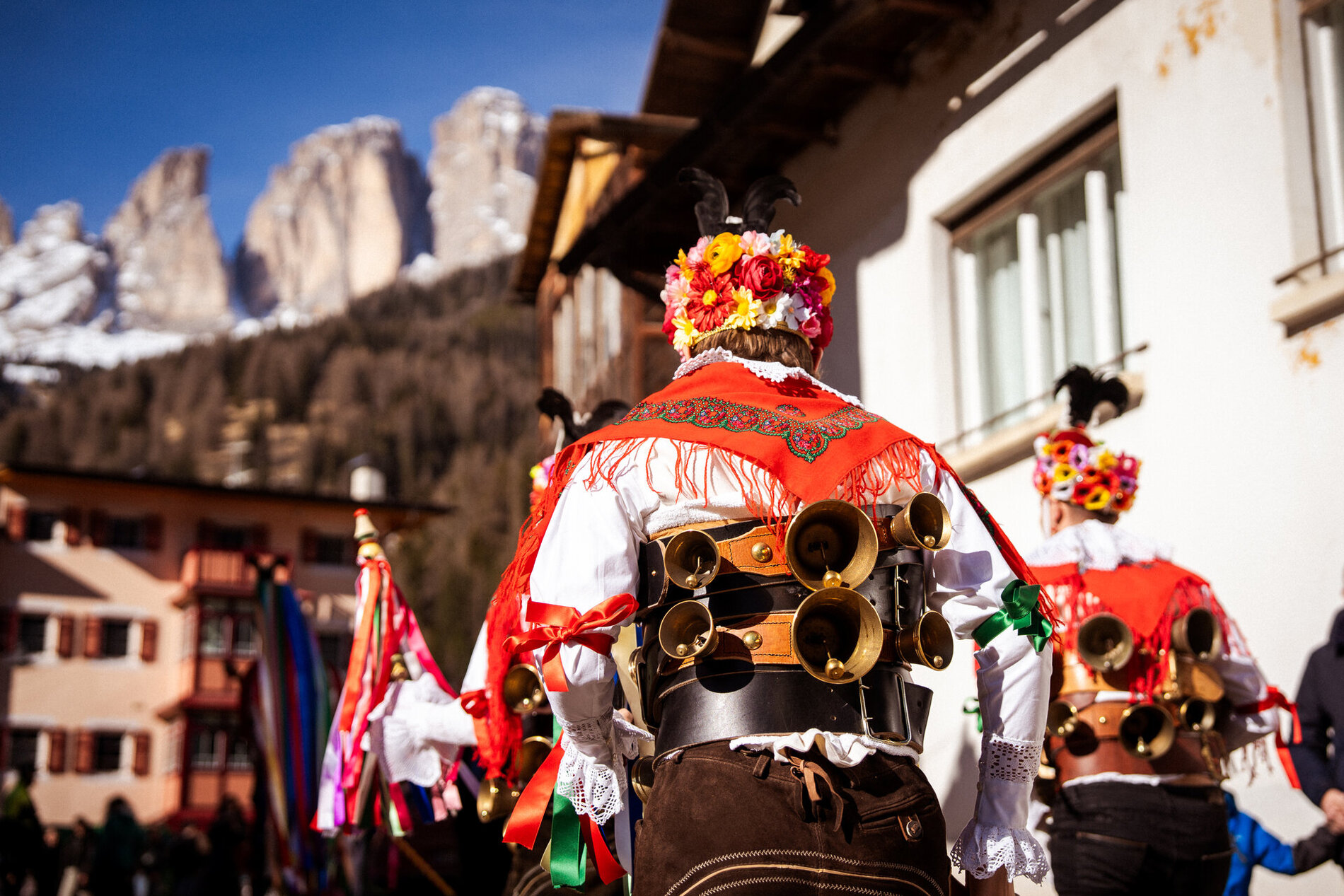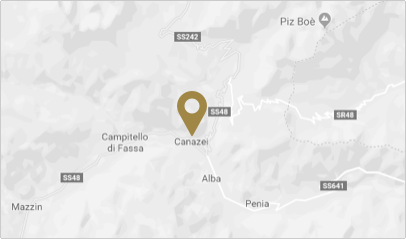
Who are the Ladins? An Alpine people who preserve a language, customs, and flavors capable of making an experience in the Dolomites truly special.
In this article, we take you on a journey to discover Ladinia, starting from Canazei in Val di Fassa: words, traditions, places to visit, and practical tips for experiencing the local culture authentically. By staying at Hotel Cristallo, you can easily move between villages, museums, and mountain huts, taste typical dishes, and participate in the events that bring the valley to life.
Who are the Ladins and where do they live: Identity of an Alpine people
The Ladins of the Dolomites are a historical linguistic minority living in five valleys around the Sella massif: Val di Fassa (Trentino), Val Badia and Val Gardena (South Tyrol), Livinallongo/Fodom and Ampezzo (Veneto). More than just an administrative border, "Ladinia" is a cultural area united by language, customs, and traditions rooted in the Alpine communities of these valleys.
The binding element of their identity is the Ladin language, a Romance language (also called "ladin dolomitan") with local variations that, despite their diversity, belong to the same family and represent a cohesive factor for the communities. The language is alive in place names, schools, and daily life. For those wishing to learn more, Ladin museums and cultural institutes offer paths dedicated to the history and modernity of the Ladin people.
In Italy, Ladin culture and language are protected by the national law on historical minorities (L. 482/1999). In South Tyrol, where three language groups coexist (German, Italian, and Ladin), this protection is part of an autonomous system that guarantees representation and public services in their respective languages. This has helped keep the Ladin identity alive over time.
For those who wish to "touch" this identity firsthand, the Museo Ladin de Fascia (Ladin Museum of Fassa) explains the origins, arts, and daily life of the Ladins in an accessible way, with permanent and temporary exhibitions also designed for families.
A brief history of the Ladins
The history of the Ladins is rooted in ancient times, long before the Dolomites became a tourist destination. After the fall of the Roman Empire, the Romanized populations inhabiting these Alpine valleys remained relatively isolated, developing their own language and culture over the centuries: Dolomite Ladin. This geographical isolation allowed for the preservation of archaic Rhaeto-Romance linguistic traits that became extinct or merged with other languages elsewhere.
In the Middle Ages, the Ladin valleys never formed a single state but remained tied to local lordships and changing borders. Despite this, the common culture was kept alive through language, religion, community festivals, and an Alpine economy based on subsistence farming, animal husbandry, and trade between valleys.
Between the 19th and 20th centuries, with the advent of Alpine tourism and major political changes (from the fall of the Austro-Hungarian Empire to the transfer of territories to the Kingdom of Italy), the Ladin community found itself defending its linguistic and cultural identity. In the post-World War II era, dedicated cultural institutes and publishing initiatives emerged, marking the beginning of active and organized protection of the language and traditions.
A fundamental moment was the approval of Law 482/1999, which recognizes and protects historical linguistic minorities in Italy, including the Ladins. In South Tyrol, moreover, this protection is part of a special autonomous framework: the German, Italian, and Ladin linguistic groups enjoy equal rights and representation in institutions, schools, and the media. This has allowed the Ladin community to strengthen its public presence and pass the language on to new generations.
Today, Ladinia is an example of multilingual coexistence and the active conservation of a truly special cultural heritage. It is not a "language of the past," but a living identity that engages with the present through school, museums, communication, and daily life in the valleys.
Ladin cultural events in Val di Fassa
Val di Fassa is a lively valley all year round, where tradition and celebration intertwine with the rhythm of the seasons. Participating in one of these events means experiencing Ladin culture up close, amidst traditional costumes, music, authentic flavors, and genuine smiles. Here are some events:
Ladin Carnival (Carnascèr de Fascia)
From January to early March, the streets of the Fassa villages fill with wooden masks, colors, and dances. The Carnascèr de Fascia is much more than a parade: it is a centuries-old tradition that features symbolic figures like the Laché and the Marascon, accompanied by choirs and live music. Each village has its own style, but the spirit is the same: celebrating the joy and identity of the valley.
Gran Festa da d’Istà (Great Summer Festival) – Canazei
Every September, Canazei becomes the meeting point for the five Ladin valleys. For three days, amidst music, typical dishes, and traditional costumes, the Gran Festa da d’Istà brings together hundreds of people in a grand embrace of culture and friendship. The final parade, with folk groups from all over the Ladin territory, is a truly unmissable moment.
Entorn Vich – Vigo di Fassa
During the summer, the streets of Vigo transform into a sensory journey of lights, scents, and Ladin tunes. Entorn Vich is an evening dedicated to flavors and traditions: the doors of old barns open to welcome tastings, crafts, and live music. An authentic experience that tells the story of village life with simplicity and warmth.
Festa ta Mont – Val San Nicolò
At the end of summer, Val San Nicolò becomes the stage for the Festa ta Mont, a tribute to life in the mountain pastures (malga) and the crafts of yesteryear. Guided hikes, workshops, storytelling, and typical dishes bring the atmosphere of an authentic Alpine pasture back to life. It is the perfect opportunity to combine nature, culture, and taste in a single day.
Tip from the Hotel Cristallo team: During your stay in Canazei, ask at the reception for the updated schedule of Ladin events. We will help you choose the nearest experiences, book visits, or easily reach the valley's locations. Furthermore, to stay updated on events, you can visit the official Val di Fassa website.
Discovering who the Ladins are means going beyond the scenic beauty of the Dolomites to immerse yourself in a living heritage made of language, rituals, flavors, and authentic hospitality. From the five valleys around the Sella, with Val di Fassa as a natural gateway, a world opens up where tradition and the present coexist every day: in greetings spoken in Ladin, in inherited costumes, in the choirs that animate the squares, and in the typical dishes shared in mountain huts.
During your stay at Hotel Cristallo, you can experience all this up close: visit museums and villages, participate in popular festivals, savor the local cuisine, and meet people who proudly preserve this unique Alpine identity.
Ladinia is not just a place to visit, but an experience to be lived with respect and curiosity, step by step, word by word, celebration by celebration.
Book here, it’s worth it! Request informationYou might be interested in...:
Offers
Request information/booking

Contatti
Hotel Cristallo - Marchioni Family
Via Dolomiti, 40 - 38032
Canazei (TN) Italy
Tel. +39 0462 601317
Fax +39 0462 601305
info@hotelcristallo.net

